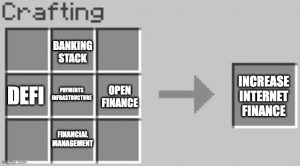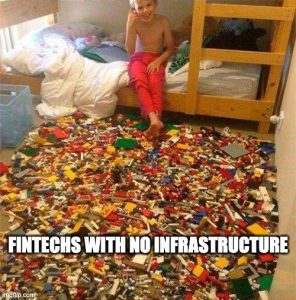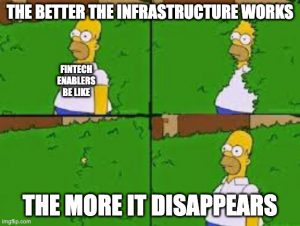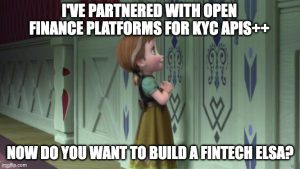A common theme across our podcast conversations with fintech founders in Southeast Asia is the value and evolution of infrastructure in the region’s growing digital financial services stack available not just to consumers but businesses as well.
We cover fintech infrastructure in these discussions as typically one of the following B’s:
- Base: Structure on top of which businesses or consumers are able to transact (e.g. protocols, payment rails, currencies)
- Building Blocks: Enabling fintechs to build and deploy faster, and be more focused on building their core product or service (e.g. API menu for fintechs)
- Bridge: Bringing greater reliability to information flows (data calls and verification) and interoperability (account access for money transfer) and creates more confidence in regulators on the capabilities of fintechs (e.g. KYC for regulators)
In this article we cover five insights from five fintech and SaaS CEOs (Fazz Financial’s Hendra Kwik, Flip’s Rafi Putra Arriyan, Brankas’ Todd Schweitzer, Xfers’ Tianwei Liu, and Verihubs’ Rick Firnando) with whom we’ve covered this topic in form or another, whether it’s discussing use cases, regulation, or simply the pain points that are begging to be solved by these fintech infrastructure solutions.
- The next internet revolution will be SME digitalization. A key part of enabling that to happen effectively is creating a cashless ecosystem, which in turn needs reliable payment or money movement infrastructure.
- Fintech evolution is also powered by infrastructure evolution, which also enables fintechs to build real-time, reliable bridges with banks / financial institutions / banking incumbents, and even other fintechs.
- The fintech infrastructure that works well disappears into the background. This is also what will ultimately happen to blockchain as a technology; real world utility trumps everything.
- Regulation on open finance (a key evolution for more seamless fintech infrastructure) is still a work-in-progress, and so fintechs in this space are better positioned to educate and be guides to regulators for the long-term benefits.
- There are many layers to fintech infrastructure and so there’s a lot of opportunity to meet these various needs or pain points, whether they be for payments or fintech enablers or crypto and DeFi.
The Payments Cornerstone

Ultimately a lot of the demand or pain points behind the evolution of fintech infrastructure boils down to payments or more generally, money movement. The demand for payment or money movement solutions itself stems from an increasing digitalization of previously offline transactions and access points for money-holding accounts. By making these money movement solutions more efficient, flexible, and agnostic, the region’s internet economy could more quickly benefit from (1) other financial services hinged on the ability to move (and verify) money from one digital account to another and (2) a wider array of use cases beyond money transfer or commerce payments.
Hendra Kwik, CEO and co-founder of Fazz Financial Group, contextualizes the impact of improving payments infrastructure especially for the SMEs that make up a significant portion of economies in Southeast Asia, and while he doesn’t explicitly mention it in this snippet, this also explains in a broader way why Payfazz (with their strong distribution and hyperlocalized approach to building for rural Indonesia) and Xfers (with their expertise in building payments infrastructure) joined forces to form Fazz Financial.
“And what I foresee in the next five years is that the evolution of the Indonesian fintech landscape will shift away from purely payment and e-money playbook into a full banking stack where people will start to offer you, instead of just payment with QR, a full banking stack where people are going to start to use this more than just for payment. They’re going to start using it for other use cases, such as investing, lending, or also buying houses with installment, et cetera. And I think this evolution is unavoidable. And a lot of fintech in the region will need to adapt to stay relevant.
Definitely, we saw the first revolution of the Indonesian tech sector — the gigantic tech companies initiated the birth of large e-commerce marketplaces and large ride-hailing [companies]. But the way I see this marketplace and ride-hailing is that they are digitalizing the merchants first, maybe in the case of the marketplace, they are digitalizing the online shops and online travel agents in the case of e-commerce giants and OTA giants. In the case of ride-hailing, they are digitizing the taxis and the ojeks. And then once those merchants are digitalized, they can start accepting cashless payments that actually finally bring a lot more users to start adopting internet finance and internet payment as well.
We also believe that the next wave of [digitalization] will happen with the offline restaurants and offline kirana stores or mom and pop shops that we call warungs in Indonesia. That’s what Payfazz has been focusing on in the last five years — how we can digitalize as many offline warungs and offline restaurants as possible.
So that one day we can turn them into cashless merchants in the same way you see today with GoPay, which was built for customers to pay offline taxis and ojeks that were offline and very cash-centric before. And we see ShopeePay and TravelokaPay being used to pay for online shops and online travel agents. That’s what we also expect to see in the future [with warungs].
Our ecosystem consists of offline merchants like restaurants and warungs tied to their customer base. They are sticky and we’re going to start to transform their way of payment from offline cash-based payment, into internet-based payment so we can realize our vision of increasing the GDP of internet payment and internet finance in Southeast Asia.”
It’s not you, it’s not me, it’s the infrastructure

Apart from enabling SME payments and financial services, fintech infrastructure is also important for fintechs themselves to scale. Indonesia’s largest digital money transfer platform Flip, founded back in 2015, has seen over the years how the evolution of fintech infrastructure in the country has coincided with the speed with which they were able to mature their product and acquire users.
Rafi Putra Arriyan, CEO and co-founder of Flip, shares how that dynamic between infrastructure and their core product evolved over time.
“But the thing that we think helps us move very fast right now is not only [that] our core product is growing, but the infrastructure around us has also become more mature. For example, when we start Flip, there is no way for us to do proper KYC. The data that we can say as a source of truth — it’s hard to get this data, but right now we have access to get this data that’s being provided by the government. There’s lots of improvement in terms of regulation [that is] helping us to build a better product and also doing better partnerships with other financial institutions or maybe the banks. All of this [has been] helping us to build a more innovative solution for our users.”
The key pain point solved by this infrastructure is the chasm between banking incumbents and fintechs, when it comes to accessing bank data and accounts for fintechs to enable specific transactions or an entire stack of services. Rafi describes how this relationship between fintechs and banks in Indonesia has evolved over the years, from complete separation to joint products, acquisitions, and open banking APIs.
“We are moving towards a better way. Before people only saw banks and fintech as separate, but there’s lots of collaboration happening [now]. If you look at the market, there are lots of startups collaborating with banks by issuing maybe a joint, co-branded debit card or mobile banking and others.
And even one of the unicorns in Indonesia has acquired some bank — actually, not just one, but several unicorns in Indonesia have acquired banks, so I’m seeing this is as a good dynamic that’s happening on the market because it creates more flexibility in terms of how, as a fintech, as a startup, [we can implement] the solution for our users, because before it’s hard for us, for example, if we wanted to [enable] our users to receive money using some banks, like three to four years ago, we cannot do that yet because the bank did not have the infrastructure.
They do not have the API for example, but currently most of the banks are already aware that they need to revolutionize the way they are doing this on the technology part. Currently, they are opening their API, partnering with fintechs and also from the regulator side, in this case in Indonesia, they are also pushing the banks to do that.
In fact, currently Indonesia is building some open API guidelines for the banks to follow. It will be better for us maybe in the next three to five years. We can have an ecosystem that is quite similar to India or the US maybe, where a fintech company could tap into the bank directly. And then we can get the data based on the [activity] of the users, and it would be really a game-changing opportunity that the users can get from that kind of product.
…Currently, if you are aware, [there are] lots of [fintech] products in Indonesia. There’s a gap in the way they can accept payments from the customer because currently the most popular method is still bank transfer, or [they] have ewallet on the platform, but still the experience is not really smooth and not really good from the user perspective, and I’m seeing if we have a capability to do direct debit seamlessly, connecting our bank account to the third party, seamlessly and securely, it will change a lot of how we interact with digital product or features.”
The Disappearing Act

The thing about infrastructure is that, much like bridges, buildings, and highways, people don’t really pay much attention to their integrity and readily take for granted their reliability — until they stop working. And when they do stop working, they can potentially cause ripple effects in disruption across an entire network or area. This means that a lot of work goes behind maintaining this infrastructure’s integrity and operational well-being, as well as its capability to support an increasing number of users (i.e. vehicles, people). And so for Fazz Financial Group Deputy CEO and Xfers CEO and co-founder Tianwei Liu, the same applies to building fintech infrastructure.
“From a product perspective, what we want to serve [go from] SMEs to very heavy enterprises. We are helping them to digitize their business. And I, as an engineer, always believe that when technology truly works it disappears. Like people actually don’t realize what is happening on the backend…So the last two years, a lot of the infrastructure [we’ve built] and investment [we’ve made go] into making sure things are regulation compliant, reducing the cost in terms of running some of these operations, and at the same time, improving the reliability and dependability of all these products.
…These days, I think the newer generation of SMEs are moving towards that direction and we want to be the [infrastructure] that is powering them and making sure that we are building out products that are hyper-local and able to serve them in their needs in the coming years. So that is where we feel we will play a very, very crucial role because of our long-term investment into the infrastructure side of things, and at the same time, the licenses that we have already secured.
…But a large part of the agent’s and people’s lives depend on us working right now. We serve probably north of half a million customers on a daily basis right now. So all these people depend on us actually being able to operate and continue staying up. Can you imagine making a payment in front of a counter and it doesn’t work? I think that itself is going to cause a lot of disruption to people’s daily life. And that’s where, when everything works, we disappear behind the background and that’s where a lot of our product and improvement have been done over the last two years.”
And this “disappearing into the background” goal for infrastructure technology applies as well to Tianwei’s views on what the long-term impact of blockchain will be, at least, in the financial services space. Ultimately, this goal is rooted in the idea that “real world utility trumps everything.”
“I fundamentally think that a lot of these things will disappear in the background. I don’t think the future of SMEs will be like accepting bitcoin payments. I don’t think that that will happen. That is not how I see it. I believe it’s just that these things are going to be fundamentally powered at the backend by blockchain technology or something that’s happening behind the scenes, but [in my] day-to-day life, I’m just making a payment to buy a coffee. Do you really need to know how the payments are being done in the background? And in the long-term I don’t think my mom would even know.
I was always telling [people] that in some sense, we are seeing a new generation of dotcoms. I was in the Valley when the dotcom bubble burst, and [how it became the] way it is, and when Amazon rose and everything. Just 10 years and 15 years back, telling people that you can buy things online, it’s like a crazy thing, right? Like what are you talking about? Today’s it’s a [fact] of life. Do people still ask you how the internet works? They don’t. It disappears in the background, businesses still continue running.
So that is the standard general trend. I think blockchain and all this stuff are just buzzwords today, but very soon it will be back to [answering the question of] how it makes these things faster, cheaper, and better for day-to-day life. Real world utility trumps everything.”
Regulation Under Construction

Another thing about infrastructure is that there needs to be alignment for all the parties it connects with regards to how it is used, as well as for the stakeholder in charge of ensuring there are standards met across all these bridges. For fintech infrastructure, that means regulation, from licenses to guidelines and roadmaps.
For companies building this infrastructure in Southeast Asia like Brankas, they are very much working with a regulatory environment that is still a work-in-progress. But according to CEO and co-founder Todd Schweitzer, the “fence” is already being built through roadmaps, circulars, and sandboxes and that’s a significant first step to eventually filling in the lines.
“I need to start by saying that open finance in Southeast Asia is a work in progress from the regulators perspective. So most of the financial regulators in Southeast Asia are at the stage where they are developing the guidelines and the first version circulars, papers, and roadmaps that will set a plan for developing the regulations later on. In other words, this is still mostly an unregulated industry, although most of the regulators, I would say, have timelines. And they are in the process of determining the kind of open finance regulatory regime they’re going to put into place.
And that is a challenge and an opportunity. It’s a challenge because the financial institutions that we work with, their compliance and IT teams, prefer to have certainty one way or another from the regulator. And so often with new tech or a not yet clearly regulated industry, they want to have some clarity on, basically what’s inbounds and what’s out of bounds.
Now what I really appreciate about regulators, particularly in the Philippines and in Indonesia, is they’ve moved fast to put out guidelines. In the Philippines, that’s the open finance circular. In Indonesia, that’s Bank Indonesia’s 2025 open banking roadmap. The visual in my head is a fence. They haven’t defined what’s inside the fence, but they have the perimeter defined.
Now when we are working on new API products that are very new to a bank’s compliance team we have some documentation from the regulator that says, “Here are the IT and industry standards and operational and reporting expectations that will be coming. So let’s start already with a pilot.” And as the regulations are more defined, at least the bank won’t have to backtrack, so that I think is a good thing.”
And because regulation is still “under construction”, the way to work with regulators, according to Todd, is not to be a cowboy in the Wild West, but a sherpa in the Himalayas, being transparent and collaborative and being a guide to developing a deeper understanding of the implications of technology.
“The other is, the approach that Brankas has taken is, not the cowboy approach of, “Do it and we’ll face the regulator if and when it becomes a problem.” I think from day one, we’ve been very transparent, black-and-white with the regulators, and this is not just with the central banks and the financial regulators. It’s also [with organizations] like the national privacy commission in the Philippines, which is a dedicated data privacy watchdog that makes sure that customer data is protected and being handled securely across industries. In Indonesia, data handling and authentication are covered across Bank Indonesia, OJK, and Comminfo the IT ministry. So I think really across the region, the regulators have been really receptive.
So our approach is being as helpful as we can possibly be to the regulator. That [open finance] is not a boogeyman. They have the benefit of case studies from other countries. We are participants in case studies in other countries and sharing that knowledge has been really helpful. We try to share our experiences of what’s happening in other countries, not just in ASEAN, but outside of Southeast Asia, for example, the open banking lessons learned, good and bad, I would say, coming out of Europe, as well as interesting open banking regimes in the Middle East now.
Late last year I joined as the director of the Open Banking Exchange in Asia and the open banking exchange or OBE is basically the large industry association for open banking FIs, technology companies, service providers, aggregators in Europe. There’s been a lot of effort with the MAS in Singapore and with the World Bank to set up OBE operations here so that the industry can come together and share these best practices in a more formal way.
So I’m excited to be participating in building the Open Banking Exchange in Asia and that’s good for Brankas. It’s good for Brankas’s competitors. and it’s good for consumers that would benefit from an open finance ecosystem here, but someone needs to, basically push that rock up the hill to come to some agreement within the industry and also share case studies with the regulators to speed up adoption. So that’s a big part of what Brankas does.”
*Knock* *Knock* Do you want to build a fintech?\

Fintech infrastructure needed for truly seamless experiences is multi-layered, and fintech CEOs on our podcast have counted several use cases that require different APIs for examples. Rick Firnando, the CEO of Indonesian infrastructure solutions startup Verihubs, talks about their company’s primary use case, verification and KYC, with respect to becoming a fintech enabler for Indonesia. He shares a specific example of a fintech startup, what they had to deal with sans this digital infrastructure, and what they can do with services like Verihubs’.
“So, before we existed, if fintechs wanted to do verification, then they had to connect with the government and extract the data by themselves. In addition, if they want to access their customers’ financial data, they have to connect with five big banks and they need to do the partnership by themselves, which is quite impossible.
And Verihubs plays an important role here. We are a fintech enabler for Indonesia. So we enable all companies to build fintechs easier using our full stack solutions ranging from accessing financial accounts and many other [services] to support fintechs in Indonesia. We believe with these solutions, this will accelerate the growth of fintechs.
To be specific for the customer story, I think the most memorable story was around eight months ago. We actually had a meeting with one of the potential customers and they told us that they still did manual verification to verify their customers.
I think back then they had 20 verificators and they needed to hire more as their number of users kept growing. And he said hiring more teams actually didn’t solve any [of their] problems because it will just cost them a lot of money and time. In addition, their user experience was really, really bad, [because] typically the user would have to wait weeks to get verified to get into the platform. So when we implemented our solutions to them, I believe they said that they saved their [costs] by around 50% and their user experience was better than before since we helped verify their customers in under five seconds.”
Verification is just one layer of infrastructure that needs to be built to not just manage the risk posed by having more fintech-driven transactions but also enabling all kinds of tech companies to incorporate financial services or any services that need some form of seamless information flows or checks, really. Rick lists down some of these other use cases or infrastructure layers needed by fintechs in Southeast Asia.
“I would say that FinTech will grow faster in Southeast Asia, because COVID basically is forcing us to go online. There will be a lot of unprecedented opportunities, especially with fintech. So everyone has to be digitalized; payment has to be digitalized, etc. But we realized unprecedented opportunities also mean there will be unprecedented risk, which is why we started to build our verification solutions. Because we believe it is one of the most important infrastructure layers for most companies, especially to prevent risk. Verification is just the tip of the iceberg in our pipeline. In the next five years, obviously we want to be the number one infrastructure layer for fintech companies in Southeast Asia.
First one would be the verification. The second one would be the open banking solutions. So open banking is quite broad. It can be used for many use cases, like to streamline the loan process and many others, and the third one we believe that it’s [about] connecting the data.
We’re doing verification. We’re doing open banking. Obviously we are [also] getting a lot of data and building and connecting the data [to] build products that can be beneficial or FinTech is what we’re looking for. One of them is basically credit scoring.”
Paulo Joquiño is a writer and content producer for tech companies, and co-author of the book Navigating ASEANnovation. He is currently Editor of Insignia Business Review, the official publication of Insignia Ventures Partners, and senior content strategist for the venture capital firm, where he started right after graduation. As a university student, he took up multiple work opportunities in content and marketing for startups in Asia. These included interning as an associate at G3 Partners, a Seoul-based marketing agency for tech startups, running tech community engagements at coworking space and business community, ASPACE Philippines, and interning at workspace marketplace FlySpaces. He graduated with a BS Management Engineering at Ateneo de Manila University in 2019.